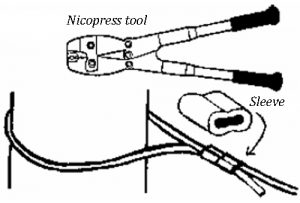Working with High Tensile Fence Wire
(Lesson 3. Fencing Systems continued)
High tensile fences are stronger and usually less expensive to build than traditional barbed and woven wire fences. Once you know a few simple wire-handling techniques you’ll find they are also easier to build.
Spinning Jenny

Make sure you have a straight jacket handy on the day you try to dispense a roll of high tensile wire without a spinning jenny. Spinning jenny is a devise used to dispense wire smoothly without kinking or tangling. Don’t try to work with high tensile wire without one.
Start at the Beginning
There is a lead end and a tail end to each spool of high tensile wire. Both ends may be visible on the spool. When wire is pulled off the spool, start with the lead end. The lead end on new rolls is identified with a tag. If you cut the wire, be sure to identify the lead end of the wire left on the spool.
Cutting Wire
You’ll wear yourself out trying to cut high tensile wire with ordinary wire cutters (you’ll also ruin your wire cutters). High tensile wire can be cut easily using high tensile wire cutters.
Tying Off
High tensile wire can be “tied off” to brace posts using knots, nicopress sleeves or wire vises.
It is easier to use a lower strength wire like 170 vs 200 to tie off.
Half Hitch Knot

High tensile wire may be stiff, but you’ll find it relatively easy to make a simple half hitch knot to fasten the wire to brace posts. The break strength half hitch is over 60% of the break strength of the wire (about 1100 pounds). To tie a half hitch:
- Pull about 3 feet of wire around the post.
- Bring the end of the wire underneath and back over the line wire.
- Bring the end down between the post and the wire that you just wrapped around the post.
- Bring the tail under the wrap and over the line wire.
- Make two tight wraps with the tail around the line wire.
- Break or cut off the tail. Cutting leaves a rough surface.
Breaking wire will leave a smooth surface. To break off excess wire:
- Put a 90° bend in the wire about 6″ beyond the knot.
- Grasp the wire just beyond the bend and crank it parallel to the fence line (back toward the post or splice). The wire will snap right off.
The faster you work, the easier the wire is to break. High tensile wire gets hot when worked slowly. When hot, the wire becomes more difficult to work and break off.
Nicopress Sleeves

Nicopress sleeves can be crimped around high tensile wires with a nicopress tool. The resulting connection has a break strength equal to that of the wire. To tie off wire with nicopress sleeves:
- Thread two nicopress sleeves (or use one long sleeve) on to the wire and slide them back about 2 feet.
- Feed the wire around the post. Thread the nicopress sleeves on the tail.
- Slide the sleeves back to within a few inches of the post.
- Crimp each sleeve with a nicopress tool.
- Break or cut off the tail.
Wire Vise

The wire vise has the same break strength as the fence wire. To install a wire vise:
- Drill a 3/8″ hole completely through the center of the brace post.
- Feed each wire a few inches through the correct hole and into the wire vise.
- Slide wire vise up the wire and into the hole in the post. When the wire is tensioned, the wire vise will become embedded in the post.
- Break or cut off the surplus wire.
Insulators and In-line Strainers

Both insulators and in-line strainers can be installed with two nicopress sleeves or by making at least 6 tight wraps with the tail around the line wire.
Splicing
Wire can be spliced using a figure “8” knot, nicopress sleeves or a “wire link.”
Many prefer a gripple over a wire vise due to cost and effectiveness.
Figure “8” Knot

The figure “8” is the most efficient knot for splicing high tensile wire. It will maintain up to 76% of the strength of the wire. To tie a figure “8”:
- Overlap the wires to be spliced by about 4 feet.
- In each piece make a small loop around the other wire. Leave yourself an 18″ tail on each wire. The tails should be pointing in opposite directions
- Tension up the figure “8” so that the tails are touching.
- Holding the figure “8” secure in the claws of a hammer, wrap the tail back onto the line wire with at least two wraps.
- Break off the excess wire.
Nicopress Sleeves
Splices can also be made using nicopress sleeves. These splices have a break strength of 100% of the wire strength. To splice with nicopress sleeves:
- Thread 3 sleeves (or 1 long sleeve) on the first wire.
- Thread the second wire through the other side of the sleeves.
- Crimp the sleeves with a nicopress tool.
- Cut or break off the tail.
Wire Links

Splices can also be made with “wire links.” Wire link splices maintain 100% of the strength of the wire. To splice with wire links:
- Insert both wires as you can in the ends of a wire link.
- Tension the wire.
